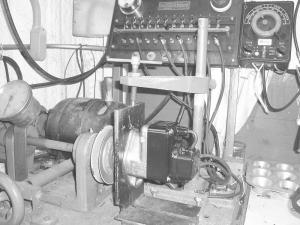2007 - Volume #31, Issue #5, Page #38
[ Sample Stories From This Issue | List of All Stories In This Issue | Print this story
| Read this issue]
He Rebuilds Antique Magnetos, Carburetors
 |
He charges $40 per hour and ships the rebuilt magnetos and carburetors by UPS.
"Rebuilding magnetos is a rare business and a lost art," says Lundin. "I don't advertise and rely entirely on word of mouth. I do work for people from all over the U.S."
A magneto is a self-contained, high voltage distributor that ignites the spark plug on older tractors that don't have a battery. It produces a spark by running magnetic energy through a magnet, coil, condenser and points.
"A lot of antique tractors have been parked outside for 50 years or more so when I rebuild the magnetos or carburetors, they're usually all rusted up. I use a sandblaster to clean up the casting. When sandblasting I use only glass beads to keep from distorting the metal.
"I also install new threads on the bottom of Deere cast iron carburetors when condensation causes the threads to rust or break. Some of these carburetors have been on the tractor for more than 70 years. I make the threads on a turning lathe using my own jigs. I also had to make my own jig for making the threads. As far as I know there are only two other people in the U.S. who make and install new threads like this."
Lundin, who retired from farming in 1992, says he has been doing this kind of work all his life. He started doing it as a business 10 years ago.
Few people are willing to work on magnetos and carburetors found on antique tractors. "Most mechanics avoid them, and no one has the tools," says Lundin. "In fact, a lot of antique tractors had battery ignition systems installed on them back in the 1950's because no one knew how to restore the magnetos.
"I have all the tools required to repair magnetos and carburetors, including coil testers, condenser testers, spark testers, and a magnetizer to charge magnets. I even had someone from Chandler, Arizona, make a digital gouse tester for me that measures how much magnetism is in a magneto's magnet. It lets me know if I'm increasing the magneto's magnetism level or if the magneto is already fully charged."
He says he can rebuild any magneto, but often he has to make parts for them. "I've even had to make my own pullers to take magnetos apart. For example, when I needed a puller for an International Harvester magneto and called the company, they said the last one they sold was way back in 1972. So I made my own, using a pattern from another mechanic who already had a puller."
Lundin says the first magneto was built in about 1890 when gas engines first came out. "I deal with the Wico Magneto Company in Chicago quite often to get parts."
Most of the work he does is on Deere tractors, "because Deere customers have a terrific loyalty".
During the winter months he conducts seminars in Arizona. "I started up a breakfast club of tractor collectors. Every year I do one seminar on carburetors and another one on magnetos. Some people say I should start up a school, but I haven't got that far yet," he notes.
Contact: FARM SHOW Followup, Earl Lundin, 402 Lake Dr., Big Stone City S. Dak. 57259 (ph 605 880-0468).

Click here to download page story appeared in.

Click here to read entire issue
To read the rest of this story, download this issue below or click here to register with your account number.




